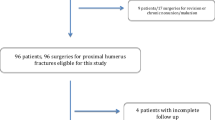Abstract
Objectives
In patients with rotational ankle fracture, we compare the rate of venous thromboembolism development between patients who received chemoprophylaxis vs those patients that received none.
Design
Retrospective cohort study.
Setting
Level I trauma center.
Patients/participants
Between 2014 and 2018, we identified 483 patients with rotational ankle fracture that had no VTE risk factors, were under 70 years of age, and had an isolated injury.
Intervention
Chemoprophylaxis vs no chemoprophylaxis after open reduction internal fixation of a rotational ankle fracture.
Main outcome measurements
Development of VTE was the primary outcome. Secondary outcomes included wound problems, infection, hematoma, or non-union.
Results
There were 313 patients that received no prophylaxis and 170 patients that received chemoprophylaxis after operative fixation of an isolated ankle fracture. Demographics including age, gender, body mass index, and ASA class were similar between groups. The rate of DVT/PE was 3.5% in those without DVT prophylaxis, and 4.1% in those on DVT prophylaxis with no significant differences found (p = 0.8). There was no significant difference in wound complication (no VTE prophylaxis—3.7% vs VTE prophylaxis—2.5%, p = 0.7) or infection rates (no VTE prophylaxis—3.8% vs VTE prophylaxis 4.1%, p = 1.0) between groups.
Conclusions
No difference was detected in the rate of symptomatic DVT or PE in patients based on chemoprophylaxis. Our results support the conclusion that the use of chemoprophylaxis may remain surgeon preference and based on patient risk factors for VTE development.
Level of evidence
Level III—retrospective cohort study.
Similar content being viewed by others
References
Goel DP, Buckley R, Devries G et al (2009) Prophylaxis of deep-vein thrombosis in fractures below the knee: a prospective randomised controlled trial. J Bone Joint Surg Br 91(3):388–394
Kock HJ, Schmit-Neuerburg KP, Hanke J et al (1995) Thromboprophylaxis with low-molecular-weight heparin in outpatients with plaster-cast immobilisation of the leg. The Lancet 346(8973):459–461
Lassen MR, Borris LC, Nakov RL (2002) Use of the low-molecular-weight heparin reviparin to prevent deep-vein thrombosis after leg injury requiring immobilization. N Engl J Med 347(10):726–730
Selby R, Geerts WH, Kreder HJ et al (2015) A double-blind, randomized controlled trial of the prevention of clinically important venous thromboembolism after isolated lower leg fractures. J Orthop Trauma 29(5):224–230
Patterson JT, Morshed S (2017) Chemoprophylaxis for venous thromboembolism in operative treatment of fractures of the tibia and distal bones: a systematic review and meta-analysis. J Orthop Trauma 31(9):453–460
Zheng X, Li D-Y, Wangyang Y et al (2016) Effect of chemical thromboprophylaxis on the rate of venous thromboembolism after treatment of foot and ankle fractures. Foot Ankle Int 37(11):1218–1224
Selby R, Geerts WH, Kreder HJ et al (2014) Symptomatic venous thromboembolism uncommon without thromboprophylaxis after isolated lower-limb fracture: the knee-to-ankle fracture (KAF) cohort study. J Bone Jt Surg 96(10):e83
Iqbal HJ, Dahab R, Barnes S (2012) UK national survey of venous thromboembolism prophylaxis in ankle fracture patients treated with plaster casts. Foot Ankle Surg 18(3):157–159
SooHoo NF, Eagan M, Krenek L et al (2011) Incidence and factors predicting pulmonary embolism and deep venous thrombosis following surgical treatment of ankle fractures. Foot Ankle Surg 17(4):259–262
Kadous A, Abdelgawad AA, Kanlic E (2012) Deep venous thrombosis and pulmonary embolism after surgical treatment of ankle fractures: a case report and review of literature. J Foot Ankle Surg 51(4):457–463
Shah K, Thevendran G, Younger A et al (2015) Deep-vein thrombosis prophylaxis in foot and ankle surgery: what is the current state of practice? Foot Ankle Spec 8(2):101–106
Stavem K, Skjaker SA, Hoel H, et al (2019) Risk factors for symptomatic venous thromboembolism following surgery for closed ankle fractures: A case-control study. Foot Ankle Surg. [Internet]. Available from: https://linkinghub.elsevier.com/retrieve/pii/S1268773119301389. Accessed 27 Nov 2019
Jameson SS, Rankin KS, Desira NL et al (2014) Pulmonary embolism following ankle fractures treated without an operation—an analysis using National Health Service data. Injury 45(8):1256–1261
Blanco JA, Slater G, Mangwani J (2018) A prospective cohort study of symptomatic venous thromboembolic events in foot and ankle trauma: the need for stratification in thromboprophylaxis? J Foot Ankle Surg 57(3):484–488
Cancienne JM, Diduch DR, Werner BC (2017) High altitude is an independent risk factor for postoperative symptomatic venous thromboembolism after knee arthroscopy: a matched case-control study of medicare patients. Arthrosc J Arthrosc Relat Surg 33(2):422–427
Jones DL, Jones WA, Fleming KI et al (2019) Underdosing of prophylactic enoxaparin is common in orthopaedic trauma and predicts 90-day venous thromboembolism. J Orthop Trauma 33(11):570–576
Baroletti SA, Goldhaber SZ (2006) Heparin-induced thrombocytopenia. Circulation 114(8):e355–e356
Neviaser AS, Chang C, Lyman S et al (2010) High incidence of complications from enoxaparin treatment after arthroplasty. Clin Orthop Relat Res 468(1):115–119
Funding
This study received no funding.
Author information
Authors and Affiliations
Corresponding author
Ethics declarations
Conflict of interest
Iain S Elliott, Ajinkya A Rane, Graham J DeKeyser, Patrick J Kellam, Phillip T Dowdle, Tommy M Safaee, Lucas S. Marchand have no conflicts of interest specifically relevant to this study. Justin M. Haller is a board or committee member of the Orthopedic Trauma Association and the Western Orthopedic Association. He is a paid consultant for NewClip Technics, Osteocentric, and Stryker.
Ethical approval
The study was conducted under University of Utah IRB 114175.
Additional information
Publisher's Note
Springer Nature remains neutral with regard to jurisdictional claims in published maps and institutional affiliations.
Rights and permissions
About this article
Cite this article
Elliott, I.S., Rane, A.A., DeKeyser, G.J. et al. Venous thromboembolism in patients with surgically treated ankle fractures. Arch Orthop Trauma Surg 143, 1237–1242 (2023). https://doi.org/10.1007/s00402-021-04192-5
Received:
Accepted:
Published:
Issue Date:
DOI: https://doi.org/10.1007/s00402-021-04192-5




